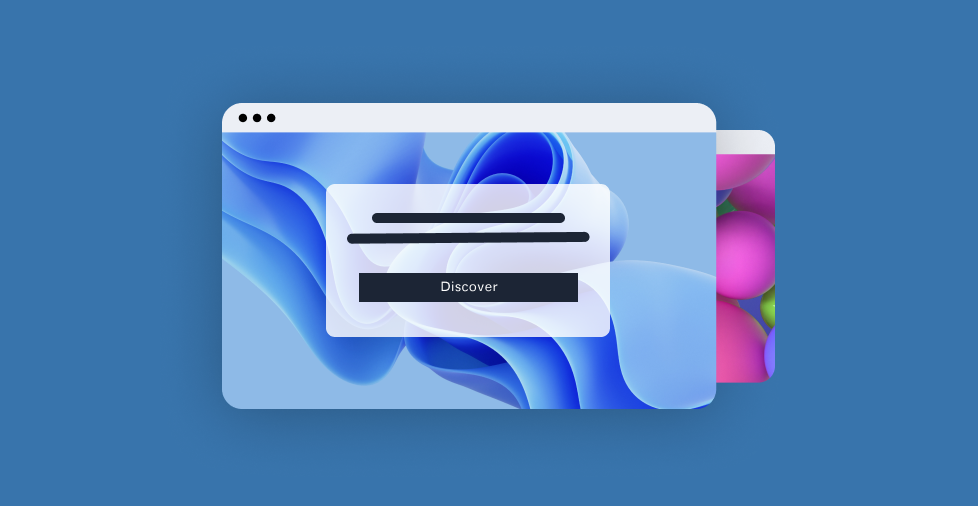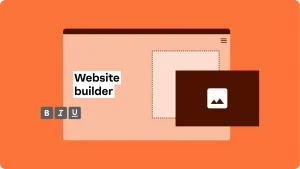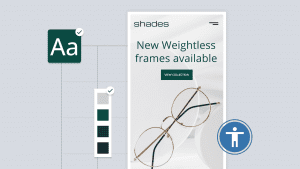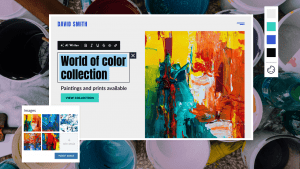Key takeaways:
- Splash pages are introductory pages that inform visitors about your website and brand.
- It also acts as a filtering tool that lets site viewers choose their language preferences and address age verification.
- An effective splash page needs to be concise. Tell your visitors what you’re about in as few words as possible.
Irish playwright and political activist George Bernard Shaw once said, “The single biggest problem in communications is the illusion that it has taken place.”
Informing your audience about your brand’s purpose and message can make a huge difference in how they relate to you. That’s where splash pages specialize.
Splash pages show up before website viewers reach a site’s homepage. They act as branding elements to convey your message or ask the reader to take action. Website designers build splash pages to be attention-grabbing to attract visitors and trigger responses.
Here, we’ll walk through the ins and outs of splash pages. You’ll learn their purpose, the best practices for building them, and some real-world examples.
What are splash pages?
A splash page is an introductory web page that appears before a visitor reaches the website’s main content. Its purpose isn’t usually to provide full site navigation but to deliver a focused message or action.
It often serves as:
- A gateway page that highlights a promotion, event, or announcement.
- A branding element to create a strong first impression.
- A filtering tool where visitors choose preferences like language, location, or age verification.
Unlike a homepage, which helps visitors navigate towards different pages, a splash page is short, attention-grabbing, and usually built around a single message or decision point.

What is the purpose of a splash page?
Website designers use splash pages to inform their customers about different facets of their website or take action, such as:
- Setting preferences
- Highlighting promotions or events
- Building brand impact
- Driving customer action
Here’s how splash pages prompt visitors to take different actions.
Setting preferences
Splash pages often ask visitors to choose settings like language, region, or age before entering the main site. This step ensures visitors get content tailored to them right from the start.
Here’s how it usually works:
- When someone lands on the splash page, they see a simple prompt such as ‘Select your country’ or ‘Choose your language’.
- The visitor clicks their choice, and the site saves that preference with a cookie or session setting.
- From there, the splash page transfers visitors to the correct website version.
And here’s why it’s important:
- Personalization. Visitors immediately see relevant content such as the applicable currency, local promotions, and the appropriate language.
- Compliance. Specific industries like alcohol or gambling, splash pages enforce age restrictions by asking for birthdate verification.
- Localization. Businesses that serve multiple countries or regions can direct visitors to the correct local site, avoiding confusion.
- User experience. The site reduces friction by setting preferences from the get-go. Visitors don’t need to adjust settings repeatedly.
Highlighting promotions or events
Websites use splash pages as attention grabbers for promotions and events. Visitors can’t miss them because they appear before the main site content.
Here’s how they do it:
- Bold visuals. Eye-catching graphics, countdown timers, or product imagery emphasize urgency and excitement.
- Focused copy. Short, clear messaging highlights the promotion, such as ‘Summer Sale—Up to 50% Off’ or ‘Join Our Live Event’.
- Strong call-to-action (CTA). Buttons, such as “Shop Now,” “Get Tickets,” or “Learn More,” direct users to the relevant page instantly.
- Limited distractions. Since splash pages strip away extra navigation, all attention is on the featured offer or event.
And here’s why it works:
- It ensures every visitor sees the promotion without digging through banners or subpages.
- It builds urgency and excitement, especially when paired with time-sensitive details.
- It helps businesses drive traffic to the most important campaign or event page.
Creating a unique visual identity for your brand and different promotions can help make them “pop”. For example, a warm color scheme works well for deals and sales in autumn. Our guide on visual identity can help you learn more about how visuals affect customer perception.
Building brand impact
Splash pages build brand impact by creating a memorable first impression. Since they appear upfront and focus on a single message or visual, businesses can set the tone for how customers perceive the brand.
Here’s how they do it:
- Immersive visuals. High-quality images, videos, or animations reflect the brand’s style and personality.
- Minimal text, maximum design. A clean, bold message paired with strong visuals reinforces brand identity without overwhelming visitors.
- Storytelling elements. Splash pages can communicate what the brand stands for in just a few seconds.
- Consistency. Colors, typography, and design align with the brand’s overall look, strengthening recognition.
And here’s why it matters:
- It sets expectations for the rest of the user’s journey, signaling professionalism and creativity.
- It differentiates the brand from competitors by showcasing uniqueness right at the start.
- It leaves a lasting impression, even if the visitor doesn’t explore the entire site.
Branding significantly affects how the public views your brand and website. Choosing distinctive colors, fonts, and design elements can make your business stand out from the competition. Check out our guide on the best website fonts to find the perfect match for your brand.
Driving customer impact
Splash pages drive customer action by stripping away distractions and focusing on one clear next step. Unlike a homepage that offers multiple navigation paths, a splash page guides the visitor toward a single decision or action.
Here’s how they do it:
- Strong CTA. Buttons like “Shop the Sale,” “Subscribe Now,” or “Enter Site” are front and center.
- Urgency cues. Limited-time offers, countdown timers, or phrases like “Only today” encourage immediate action.
- Simple layout. Minimal text and no clutter drive visitors’ attention naturally to the CTA.
- Exclusive feel. Messaging such as “Be the first to know” or “Members-only access” creates a sense of privilege that motivates clicks.
And here’s why it works:
- Visitors don’t have to think about where to go — they’re directed straight to the priority action.
- It aligns with campaign goals, whether boosting sales, collecting emails, or funneling users to an event page.
- It reduces friction by making the desired action the easiest choice.

What’s the difference between splash, home, and landing pages?
Your average internet user might conflate splash, home, and into one definition. However, each page has its own function. Here’s how they work:
- Homepage. Helps visitors navigate to the different sections of a website.
- Landing page. Directs visitors towards a singular marketing goal to drive conversions.
- Splash page. Provides introductory information for setting expectations, capturing attention, or conveying a message.
Our guide on homepage design will help you build pages that will stand the test of time.
Here’s a side-by-side comparison of each page to help you differentiate the three:
| Splash page | Homepage | Landing page | |
| Purpose | Acts as an entry point before the main site, often for promotions, settings, or announcements | Serves as the main hub of a website, guiding visitors to different sections | Focuses on one campaign or goal, like sign-ups, downloads, or sales |
| Content | Minimal text, strong visuals, single message or choice | Broad overview of brand, products, or services | Targeted content tied to a specific ad, email, or campaign |
| Navigation | Usually limited or none; users must click through to continue | Full site navigation with menus and links | Very limited navigation, often just a CTA |
| CTA | Direct and straightforward, e.g., “Enter Site”, “Shop Now” | Multiple CTAs (learn more, explore products, contact, etc.) | Single, focused CTA tied to campaign goals |
| When to use | To grab attention with promotions, set preferences, or create brand impact | To welcome visitors and give access to all main sections of the site | To convert traffic from ads, emails, or social campaigns into leads or sales |
| User experience | Quick, attention-grabbing, but can feel like a barrier if overused | Comprehensive, guiding users deeper into the site | Streamlined and conversion-driven |
If you’re having trouble building landing pages that convert, our guide to building a successful landing page can help.
What are the pros and cons of splash pages?
Splash pages can be powerful when used thoughtfully, but they also have drawbacks if misused. Here’s a breakdown:
Splash page pros:
- Instant attention. They force visitors to focus on one key message.
- Brand impact. Strong visuals and design can set the tone and make a memorable first impression.
- Targeting and filtering. They improve the user experience and targeting by setting language selection, location preferences, or age verification before entry.
- Campaign visibility. They ensure that every visitor sees time-sensitive promotions or announcements.
- Data collection. They encourage sign-ups or opt-ins.
Splash page cons:
- User friction. Adds an extra step before reaching the actual site, which may frustrate some visitors.
- Bounce risk. If the splash page feels irrelevant or slow to load, users may leave before exploring the site.
- SEO limitations. Limits SEO performance since search engines tend to penalize splash pages for thin content.
- Accessibility concerns. Can create barriers for users with disabilities if poorly designed and implemented.
- Overuse can backfire. If every visit starts with a splash page, it feels more like an obstacle than an experience.
Splash pages work best for specific, time-sensitive, or brand-driven goals. They should never replace a homepage.
What are best practices for building a successful splash page?
Building an effective splash page is a science. Overusing or improperly designing one can negatively impact your brand. Here’s what you need to do:
- Keep it simple. Minimal text and one clear message can help visitors relate to your brand or promotion.
- Use strong visuals. High-quality images or videos help capture attention and reinforce your brand.
- Prioritize speed. You’ll risk losing your audience if the splash page fails to load.
- Have a clear CTA. Buttons like “Enter Site,” “Shop Now,” or “Subscribe” help visitors decide on what to do next.
- Limit distractions. Unnecessary links or menus can take focus away from your goal. Keep the page concise to increase the impact.
- Make it relevant. Splash pages should be used only for important messages, promotions, or preferences — not for every visit.
- Ensure accessibility. The user experience can affect the page’s click-through rate (CTR) — design with readability and mobile responsiveness in mind.
- Use timing wisely. Cookies can eliminate repeated splash page display for repeat visitors.
- Create urgency carefully. Countdown timers or limited offers can work, but don’t overdo it, or you’ll lose trust.
- Test and optimize. Splash page effectiveness changes based on timing. Track performance and adjust design, copy, or CTA placement.

What are some real-world examples of effective splash pages?
A splash page can improve your brand and how your audience perceives and interacts. But actions speak louder than words. Here are five examples of how brands effectively used splash pages:
- Bell’s Brewery: Age Verification with Personality
This splash page checks for legal drinking age with a branded twist — using playful “caution tape” messaging to add personality while staying functional. It delivers compliance smoothly without sacrificing user experience.
- IKEA: Country & Language Selector
IKEA’s splash page prompts visitors to choose their country and language before entering. The clean and intuitive layout ensures users land in the right localized experience.
- Reserved: Global Reach, Minimal Design
Reserved uses a minimalistic splash page for delivery country and language selection that’s on-brand and elegant. The simplicity ensures clarity and quick entry into the shopping experience.
- Topicals: Personalized Mystery Discount
Topicals asks users to select their skin concern before revealing a “mystery discount.” This approach blends personalization with promotion and makes the experience feel custom-tailored.
- Fragment: Cinematic Brand Intro
Fragment’s splash page foregoes form or button, opting for bold animated visuals and mission-driven copy instead. It works like a cinematic prologue, instantly setting brand tone and drawing users into the story.
| Splash page of what brand | Purpose | Why it stands out |
| Bell’s Brewery | Legal age verification | Fun branding meets compliance seamlessly |
| IKEA | Locale/language selection | Clean, intuitive interface for localization |
| Reserved | Locale and delivery selection | Minimal design with clear, purposeful functionality |
| Topicals | Personalized promotion | Engaging, targeted experience with mystery reveal |
| Fragment | Branding & immersion | Visual storytelling that captures attention quickly |
Design an effective splash page with Network Solutions
Splash pages are important for communicating messages, preferences, and promotions with your audiences. They are most effective when minimal, visual, and straight to the point.
With Network Solutions and our AI-powered website builder, you can build an effective splash page for any purpose. With the help of our industry templates and AI assistant, you can get your splash page running in a matter of minutes!
Frequently asked questions
Not really. Splash pages usually have minimal text and little keyword value, so they don’t help much with search rankings. Search engines prefer content-rich pages.
Use a splash page for specific purposes, such as announcing a major promotion, enforcing age restrictions, collecting preferences, or showcasing a brand campaign.
A splash page is an introductory page before the main site, often with a single message or choice. A landing page, on the other hand, is campaign-driven — it’s where visitors “land” after clicking an ad or link, and it focuses on one conversion goal.




